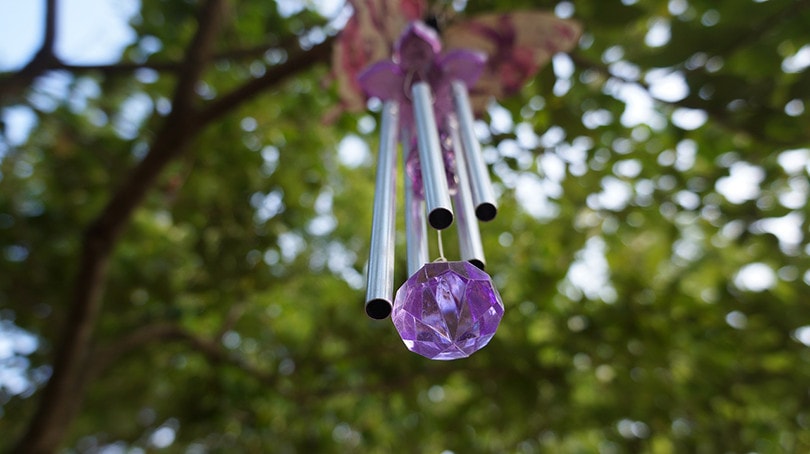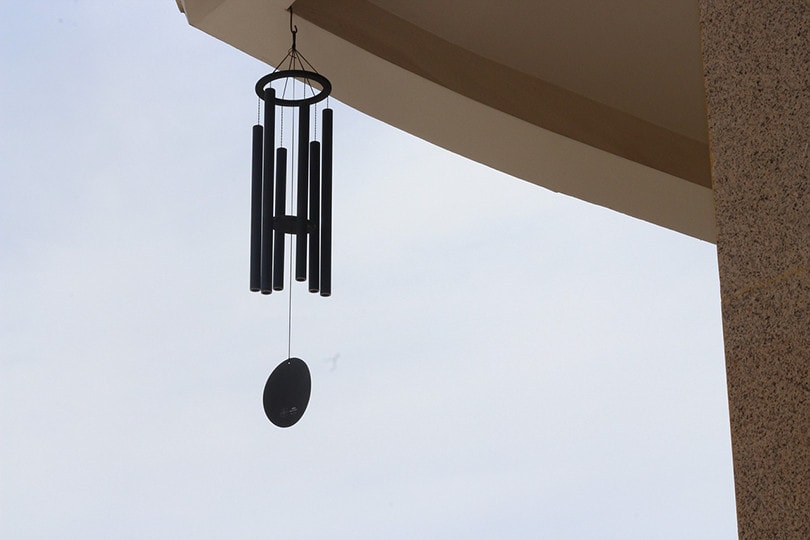Do Wind Chimes Keep Birds Away?
Last Updated on

Visiting birds fill your yard with song and consume unwanted insects from the landscape, but they can also become problematic. Garden fruits and vegetables are the favorite treats of our winged friends, and they can cause problems when they nest in awkward spaces and use your window sill as a toilet. Hanging wind chimes can encourage the birds to leave, but smaller models are less effective than the louder, larger chimes. The noise from the chimes can irritate birds enough that they’ll depart, but they can become tolerant of the sound and return.

The 10 Best Ways To Repel Birds
Although you can repel birds with wind chimes, you can also use other techniques to discourage bird parties in your yard. Birds are intelligent beings that a deterrent may fool for a short time, but they’ll return to the same area if the device seems less irritating or threatening.
1. Chimes
Large chimes are more annoying to birds, but you’ll need to install them in an area that receives plenty of wind. Hanging one in the corner of a fence or porch will not generate as much sound since it’s blocked on two sides from the wind. Loud chimes may drive away the winged invaders, but they can also irritate your neighbors.

2. Scarecrows
The scarecrow technique can convince birds to gather elsewhere, but fake predators do not fool every bird. Owls often hunt songbirds and their offspring, and some smaller birds may be deterred from your property when they see their enemy lurking near a window or garden. You can spend a few dollars more for a model that lights up and emits owl sounds, but an inexpensive plastic decoy may be all you need. Some homeowners have had success using a fake owl combined with other deterrents.
3. Garden Netting
Fruit trees and other small plants can be protected from raiding birds by covering them with protective bird netting. Birds will not land on a bush covered with mesh, but they may try to come in through the bottom. After wrapping the plant, you can tie the ends to the bottom of the trunk to prevent access to the interior. Check the net carefully for gaps or access points that are not entirely covered. If a bird comes in through a small opening, it may have trouble finding the exit and can become trapped in the net.
4. Scat Mats
Deterrent mats have raised rubber spikes that make a landing uncomfortable, but they do not harm the bird. The mats can prevent nesting and keep birds from defecating on your windowsill or deck. Some mats can be attached with adhesive tape, and others require you to install screws into a hard surface like wood or brick. If you need to keep the mats out for several months, look for heavy-duty products with UV protection that can withstand extreme temperatures.

5. Metal or Plastic Spikes
Metal spikes have been used in urban areas to prevent pigeons and other flocking birds from making a mess on cars, but their use is controversial. Although birds avoid the spikes before landing on them, some activists believe limiting a bird’s nesting spots is cruel. Instead of using metal ones, you can use plastic points to prevent birds from disturbing your deck, fence, or patio. Some homeowners do not like the way the spikes look, but they’re effective at keeping birds away.
Several businesses and homeowners use the spikes on buildings, but a property manager in Clifton, Bristol, England, placed plastic spikes on tree branches to protect the luxury cars underneath. Although the points do not harm birds, some nearby residents were outraged that pigeons were prevented from perching on trees.
6. Reflective Strips
If birds attack your garden, you can use reflective strips to deter them. Reflective mylar reflects sunlight and interferes with a bird’s landing process. You can tie the material to branches or attach it to stakes that you place around the garden. The material is more effective when it’s windy because the rustling and moving colors are more distracting to birds than stagnant pieces.

7. Reflective Globes
You’ve probably seen reflective globes in gardens and displayed in stores, but they’re more than just decorative items. Like the reflective tape, the spheres, also called garden balloons, reflect light on sunny days. You may have to put several in your garden to keep the birds away, and they’re not as helpful when it’s cloudy.
8. Noise Deterrents
A motion-activated deterrent can keep birds away from landings and garden areas. Some products have lights and sounds, and others rely only on ultrasonic waves. Some gardeners have succeeded with ultrasonic devices, but studies on the devices’ efficacy have not determined that they’re effective against insects, rodents, or birds. Birds have a similar range of hearing as humans, and it’s unclear why a bird would be bothered by sound waves it cannot hear. We suggest only using the noise makers that make audible sounds to repel birds.

9. Feeder Modifications
Birds often congregate on deck rails and fences while waiting for their turns at the bird feeder, but you can reposition the feeders to minimize the bird droppings in your yard. Move the feeders closer to trees and bushes, so they’ll use branches instead of your porch or deck. Some species, like blue jays, prefer standing feeders installed near bushes because they offer more privacy than hanging units. If the birds are problematic, even when you move the feeders, you can remove them, so they’ll find another yard to visit.
10. Garden Fleece
Frost covers, also called garden fleece, protect plants and herbs from frost, but they also prevent birds from robbing your fruit. Garden fleece is affordable and easy to attach to small trees and bushes. You can tie it to the plant’s trunk with twine or elastic tape. On hot days, you’ll need to remove it to prevent overheating.

Are Wind Chimes an Affordable Deterrent?
Compared to the other repellents, wind chimes are the most expensive option. Smaller chimes are inexpensive, but you’ll need a large set to keep birds away. Decorative handmade chimes can cost a few hundred dollars, but most deterrents like spikes, globes, and fleece are less than $30. However, premium chimes are attractive, and you can use other impediments to repel the birds if you like how the chimes sound. We suggest trying the deterrent mats or reflective strips before purchasing a fancy windchime or high-tech noisemaker.

Conclusion
Wind chimes can deter birds if they produce enough noise and are positioned in windy areas, but some birds will ignore the sound after they become accustomed to it. Adding rubber spike mats or plastic spikes to the landing area can make it unappealing to birds, and reflective objects and tape can create bright reflections that disorient birds trying to land. Fake owls and noisemakers are other options, but they’re not as successful as other physical deterrents.
Featured Image Credit: angelsover, Pixabay
About the Author Robert Sparks
Robert’s obsession with all things optical started early in life, when his optician father would bring home prototypes for Robert to play with. Nowadays, Robert is dedicated to helping others find the right optics for their needs. His hobbies include astronomy, astrophysics, and model building. Originally from Newark, NJ, he resides in Santa Fe, New Mexico, where the nighttime skies are filled with glittering stars.
Related Articles:
10 Types of Hummingbirds in Arkansas (With Pictures)
8 Types of Hummingbirds in Nebraska (With Pictures)
5 Types of Hummingbirds in Idaho (With Pictures)
3 Types of Hummingbirds in Mississippi (With Pictures)
8 Types of Hummingbirds in Kansas (With Pictures)
5 Types of Hummingbirds in West Virginia (With Pictures)
5 Types of Hummingbirds in Ohio (With Pictures)
Where Do Nuthatches Nest? Nuthatch Nesting Habits Explained
